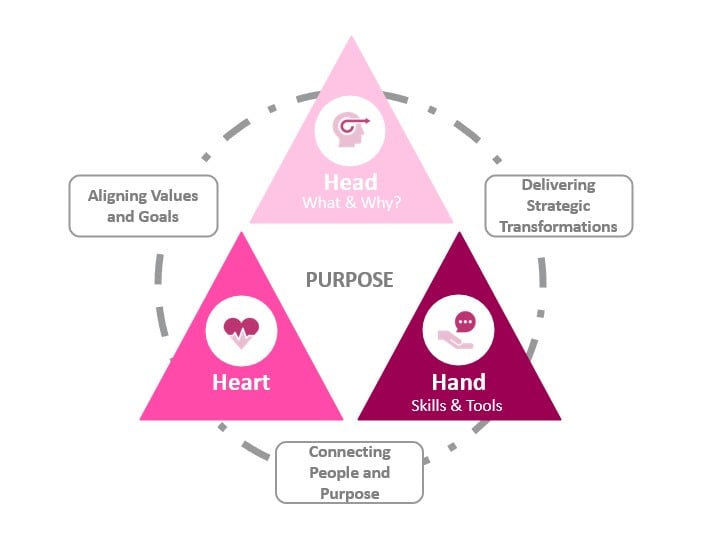
Can Purpose help financial institutions meet their environmental and social goals?
27 July 2022
We are living in a period of unprecedented uncertainty. From the increased cost of living, heightened geopolitical tension and the resulting economic shock; to the growing impacts of climate change and social inequality. On top of these, financial services are faced with an increasingly complex regulatory environment, rising ESG scrutiny and questions of trust and leadership. Quite rightly, you don’t know where to focus your strategic efforts. We believe that defining and connecting with your purpose can help provide this direction through uncertain times.
For us, purpose is the ‘why’ at the centre of your business: your ‘North Star’. A strong purpose sets a long-term goal and aspiration, grounded in the distinct capabilities and resources of the business; and informs how the people in the business behave, both directly through its operations, and indirectly within society.
In today’s world, having a clearly articulated purpose is imperative for all businesses. Defining your purpose is the first step in establishing a shared understanding between internal and external stakeholders. This can help attract investors, customers, and employees that align with an organisation’s culture and values. Research shows that a 10% improvement in employees’ connection with the mission or purpose of their organisation would result in an 8.1% decrease in turnover, and a 4.4% increase in profitability . As Alex Edman highlights in his thought-provoking book, Grow the Pie, focusing on your intrinsic purpose, underpinned by a social value understanding, can and should provide higher long-term returns to investors, as well as maximise social value.
By connecting your purpose to your business strategy, organisations can make more considered and meaningful business decisions, using the why to guide the how and the what. This is especially true for financial institutions as they continue their efforts to regain customer trust and loyalty following the fallouts of the 2008 financial crisis.
So, we have established that purpose is necessary, but how can it help financial institutions meet their sustainability goals?
As financial institutions continue to set ambitious sustainability (including ESG and net zero) strategies, we’re seeing tensions in the feasibility of their implementation. Our belief is that this is due to a lack of, or disconnect with, the organisational purpose.
We’ve identified three components to help financial institutions understand and embed purpose in their businesses:
Defining Purpose: Setting out a framework for thinking about purpose
THE HEAD – Establishing the why to aim for long term sustainability
Setting targets isn’t enough! By focusing solely on the regulation and reporting of ESG, financial institutions are failing to connect with the wider sustainability challenges that they both want and need to address in order to achieve long-term viability. The transition to a sustainable operating model will require significant changes to current operational structures, polices and processes. This must be guided by achievable, yet ambitious sustainability and business strategies, and enabled by innovation and purpose. To do this, and appeal to the head, financial institutions should:
-
Understand the context: Determine where your organisation sits in the ‘system’ and the problems at play, and which improvements and changes need to be made. Dig deep into these to determine any underlying problems or obstacles. And keep asking, ‘why is this important for us and our stakeholders?’
-
Get closer to your stakeholders: Start a deeper dialogue with internal and external stakeholders. This includes employees, shareholders, investors, customers and the wider community served. Create mechanisms to allow you to hear all the voices that are impacted by your products and services. Question and explore internally held views in a wider context.
-
Understand materiality: It is impossible to prioritise your aspirations and goals without understanding what is important to you. Use your purpose to understand what issues are causing material risks according to your stakeholders.
-
Be clear on the benefits: Articulate the long-term value you create for employees, customers and the wider community to establish an inclusive and collaborative environment. This will help gain buy-in and support on your change journey.
Appealing to the head: 52% of purpose-driven companies experienced over 10% growth compared with 42% of non-purpose-driven companies.
THE HEART - Unlocking deeper motivation
To effectively land your strategy, you cannot appeal only to the head but will also need real buy-in from your stakeholders across all levels. To do this successfully, you will need to understand the motivations of these stakeholders and get them to connect with your purpose, thus appealing to the heart. This can be achieved by:
-
Connecting purpose-driven sustainability goals to individual tasks: Articulate the link between your organisational purpose and the role that your employees play in delivering this. Encourage individual expressions of and connections with this purpose to tap into the true motivations of your employees.
Avoid overlooking the heart: Facebook - employee walkout following Facebook's (now Meta) inaction over Trump's posts inciting violence.
-
Understanding motivations to make change stick: You need to create the space and dynamics to enable your stakeholders to engage with your purpose. This in turn will help change stick. Only by connecting with your why, will your employees be able to change what they are doing or how they are doing it.
THE HAND - Enhancing skills and shifting leadership mindsets
To successfully deliver your purpose-driven sustainability strategy, you need to ensure you have the right skills, tools and leadership mindsets in place, thus enabling the hand.
-
Improving your operating practices and policies: All financial institutions will face different challenges, but you cannot continue to do the same thing and expect different results. Operating policies and practices need to evolve and align to your purpose-driven sustainability strategy. In practice, this will range from longer-term investment appraisals, to changing risk categories, to updated product design principles, the specifics being tailored to an organisation depending on their purpose.
-
Engaging and developing your leaders: Leaders of financial institutions need to live and breathe their firms’ purpose to connect the head, the heart, and the hand. Leaders must:
-
Have a values-based leadership approach, a sense of agency and a worldview that is consistent with achieving purposeful leadership;
-
Connect the wider context and industry knowledge to create innovative commercial and social value;
-
Nurture teams to enhance practices and skills through experimentation and maintain personal resilience to deliver results;
-
Be reflective and adaptive – continually learning and unlearning and hold themselves accountable.
Connecting with the hand: NatWest has put purpose into practice through leadership coaching, respecting that it is a marathon not a sprint. This has enabled widespread successful transformation of operating procedures and policies to connect purpose with practices.
Ultimately, it comes down to fully understanding the areas that are truly important and material to your organisation. Once established, you need to articulate and communicate your purpose, which is authentic to the core of your business. And finally, it will be necessary to update and implement new practices, and ensure you have the right leadership in place, with a mindset to enable success.
While uncovering and embedding your purpose, and using it to drive your sustainability strategy, takes time and effort, it is essential to ensure the future viability of financial institutions and provide a consistent anchor in a period of political, economic and operational uncertainty.
Wherever you are on this journey, Baringa can help. We bring our personal passion, as well as our deep and varied expertise, to help you develop, deliver and embed your purpose.
Related Insights

Future-proofing climate disclosures: Leveraging climate reporting for nature
Forward-thinking companies are integrating climate and nature into their strategies to drive innovation and resilience.
Read more
Transition planning in turbulent times: How financial institutions can adapt and lead
The shift to a low-carbon economy is challenging for financial institutions; we explore how they can adapt and lead in today's tough landscape.
Read more
Simplification Omnibus: what you need to know and where to go from here
We share what the Simplification Omnibus means for CSRD, CS3D and the EU Taxonomy and how you should respond.
Read more
2025 Outlook: What lies ahead for climate and sustainability in financial services?
Here's what's front of our minds for 2025 based on our dialogue with, and work for, climate and sustainability leaders across financial institutions.
Read moreIs digital and AI delivering what your business needs?
Digital and AI can solve your toughest challenges and elevate your business performance. But success isn’t always straightforward. Where can you unlock opportunity? And what does it take to set the foundation for lasting success?
